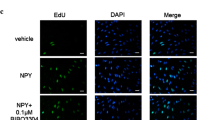Abstract
Human phosphatase and tensin homolog (hPTEN) gene was expressed in vascular smooth muscle cells (VSMCs) to study its effect on VSMC proliferation induced in platelet-derived growth factor (PDGF) conditioned medium. After G418 selection, MTT assay was conducted to examine transfected VSMC proliferation induced in human PDGF conditioned medium. We successfully constructed eukaryotic expression vector pcDNA4/myc-His-PTEN and transferred into VSMC cells. We report that in vitro proliferation of VSMC was inhibited in PTEN transfected VSMCs induced in PDGF conditioned medium. RT-PCR and Western blot results indicated significantly high levels of protein kinase B-PKB and nuclear factor kappa B mRNA and protein, respectively, in PDGF group as compared with the control group.








Similar content being viewed by others
References
Kähäri, V. M., Chen, Y. Q., Su, M. W., Ramirez, F., & Uitto, J. (1990). Tumor necrosis factor-α and Interferon-γ suppress the activation of human type I collagen gene expression by transforming growth factor-β1. Evidence for two distinct mechanisms of inhibition at the transcriptional and posttranscriptional levels. Journal of Clinical Investigation, 86(5), 1489–1495.
Faries, P. L., Rohan, D. I., Wyers, M. C., Marin, M. L., Hollier, L. H., Quist, W. C., et al. (2002). Vascular smooth muscle cells derived from atherosclerotic human arteries exhibit greater adhesion, migration, and proliferation than venous cells. Journal of Surgical Research, 104(1), 22–28.
Nilsson, J. (1993). Cytokines and smooth muscle cells in atherosclerosis. Cardiovascular Research, 27(7), 1184–1190.
Liu, Z., Hou, P., Ji, M., Guan, H., Studeman, K., Jensen, K., et al. (2008). Highly prevalent genetic alterations in receptor tyrosine kinases and phosphatidylinositol 3-kinase/akt and mitogen-activated protein kinase pathways in anaplastic and follicular thyroid cancers. Journal of Clinical Endocrinology and Metabolism, 93(8), 3106–3116.
Braun-Dullaeus, R. C., Mann, M. J., Seay, U., Zhang, L., von Der Leyen, H. E., Morris, R. E., et al. (2001). Cell cycle protein expression in vascular smooth muscle cells in vitro and in vivo is regulated through phosphatidylinositol 3-kinase and mammalian target of rapamycin. Arteriosclerosis, Thrombosis, and Vascular Biology, 21(7), 1152–1158.
Downward, J. (1998). Mechanisms and consequences of activation of protein kinase B/Akt. Current Opinion in Cell Biology, 10(2), 262–267.
Blanco-Aparicio, C., Renner, O., Leal, J. F., & Carnero, A. (2007). PTEN, more than the AKT pathway. Carcinogenesis, 28(7), 1379–1386.
Sarbassov, D. D., Guertin, D. A., Ali, S. M., & Sabatini, D. M. (2005). Phosphorylation and regulation of Akt/PKB by the rictor-mTOR complex. Science, 307(5712), 1098–1101.
Myers, M. P., Pass, I., Batty, I. H., Van der Kaay, J., Stolarov, J. P., Hemmings, B. A., et al. (1998). The lipid phosphatase activity of PTEN is critical for its tumor supressor function. Proceeding of the National Academy of Science of the USA, 95(23), 13513–13518.
Kempe, S., Kestler, H., Lasar, A., & Wirth, T. (2005). NF-kappa B controls the global pro-inflammatory response in endothelial cells: evidence for the regulation of a pro-atherogenic program. Nucleic Acids Research, 33(16), 5308–5319.
Horie, S., Harada, T., Mitsunari, M., Taniguchi, F., Iwabe, T., & Terakawa, N. (2005). Progesterone and progestational compounds attenuate tumor necrosis factor alpha-induced interleukin-8 production via nuclear factor kappa B inactivation in endometriotic stromal cells. Fertility and Sterility, 83(5), 1530–1535.
Li, D. M., & Sun, H. (1997). TEP1, encoded by a candidate tumor suppressor locus, is a novel protein tyrosine phosphatase regulated by transforming growth factor beta. Cancer Research, 57(11), 2124–2129.
Meng, F., & D’Mello, S. R. (2003). NF-kappa B stimulates Akt phosphorylation and gene expression by distinct signaling mechanisms. Biochimica et Biophysica Acta, 1630(1), 35–40.
Author information
Authors and Affiliations
Corresponding author
Rights and permissions
About this article
Cite this article
Hu, C., Liu, S., Sun, Y. et al. Effect of Recombinant hPTEN Gene Expression on PDGF Induced VSMC Proliferation. Cell Biochem Biophys 70, 1185–1190 (2014). https://doi.org/10.1007/s12013-014-0039-9
Published:
Issue Date:
DOI: https://doi.org/10.1007/s12013-014-0039-9




